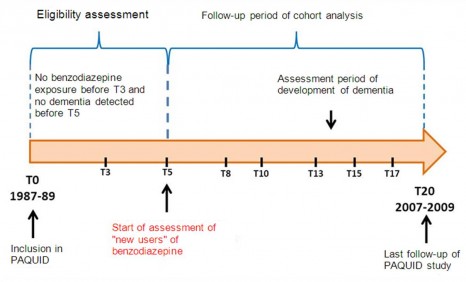Sorry, this article is only available in French.
Month: September 2012
Benzodiazepine use and dementia in the over 65s

Benzodiazepines are prescribed to treat symptoms of anxiety and sleeping disorders. Collaborative research conducted by researchers from three Inserm units in Bordeaux has recently highlighted the link between benzodiazepine use and the development of dementia in the over 65s. The researchers analysed a sample from the PAQUID[1] cohort, consisting of individuals with a mean age of over 78, who were monitored for 15 years. The results from comparative analysis of this population demonstrate the risk of developing dementia increased by 50% for subjects who consumed benzodiazepines during the follow-up period, compared with those who had never used benzodiazepines. Although this study does not confirm a cause and effect relationship, as is the case for all epidemiological research, the researchers recommend increased vigilance when using these molecules, which remain useful in the treatment of insomnia and anxiety in elderly patients.
In France, approximately 30% of individuals over 65 are prescribed benzodiazepines to treat the symptoms of anxiety and sleep disorders. The prescription of these molecules is widespread, especially in France and other countries such as Canada, Spain and Australia. Consumption of benzodiazepines is often chronic, with many people taking them over a period (often several years) that significantly exceeds recommended good practice guidelines that suggest limiting the duration to two to four weeks. The effects of benzodiazepines on cognition have been the subject of several studies with much-debated results.
On 28 September 2012, researchers from Inserm unit 657 “Pharmacoepidemiology and the assessment of the impact of health products on the population”, 897 “Inserm Research Centre into epidemiology and biostatistics” and 708 “Neuroepidemiology”, in collaboration with the Université de Bordeaux, published on-line the sophisticated results of analyses from a cohort of elderly individuals to improve knowledge of the relationship between the use of benzodiazepines and the development of dementia.
In an attempt to counteract the bias that may have restricted the scope of previous studies, the researchers completed several comparative analyses using data from the PAQUID cohort, covering 3777 individuals from between 1897 and 1989.
Diagram: Study design for cohort analyses
© Inserm / J.Hardy
The main study focused on a sample of 1063 individuals from the PAQUID cohort (mean age of 78), who were free from dementia symptoms at the beginning of the follow-up period and who had not consumed any benzodiazepines prior to the fifth year in the follow-up period (see above diagram). Out of the 1063 individuals, 95 used benzodiazepines from the fifth year onwards, thus defining two populations: those “exposed to benzodiazepines” and those “not exposed to benzodiazepines”. The annual occurrence of dementia observed in the exposed group is 4.8 individuals out of 100, compared with 3.2 individuals out of 100 for the “non-exposed” group.
“The analysis of the cases of dementia in the first population group shows that individuals who began treatment after five years during the follow-up period had an increased risk of developing dementia” states Tobias Kurth, an Inserm research director. “We wanted to check the robustness of this result by completing two additional analyses” he adds.
The second analysis consisted of creating five “small” cohorts using the sample studied previously. The researchers demonstrated that the link between benzodiazepine and dementia is robust, although the date treatment began does vary (benzodiazepine consumed from T5, T8, T10, T13, and T15).
To supplement these results, the researchers completed a case-control study on 1633 individuals with dementia (case) and 1810 without any dementia symptoms (control), all taken from the initial PAQUID population. For each time T studied, each case was compared with one or several individuals from the control group. This last analysis confirmed the trend observed in the main study, regardless of the previous exposure duration (three to five years for recent users to more than 10 years for users who had always taken benzodiazepines during the follow-up period).
“According to our analysis, benzodiazepine exposure for the over-65s is linked to an increased risk of dementia. Although we cannot prove a cause and effect relationship, we observed that during the follow-up period benzodiazepine users had a risk of developing dementia that was 50% higher than those who had never taken benzodiazepine”
indicates Bernard Bégaud.
Although these molecules are useful to treat insomnia and anxiety, the authors of this study indicate that their consumption may lead to adverse effects, such as falls. Since this new data confirms that from the four previous studies, the researchers recommend “limiting prescriptions to periods of a few weeks and taking care to ensure these molecules are used correctly. We doubt that consumption over a period of a few weeks can have a negative impact on the risk of dementia”, concludes Bernard Bégaud. Furthermore, additional studies would also make it possible to ascertain whether this link is found in persons aged under 65.
[1] PAQUID (Personnes Agées QUID), cohort launched in 1988, of a population of subjects living in their own homes in two départements in South-West France, la Gironde and la Dordogne.
3777 subjects aged 65 and over took part in the study.
Jeudi 27 septembre 2012
Sorry, this article is only available in French.
Mercredi 26 septembre 2012
Sorry, this article is only available in French.
Mardi 25 septembre 2012
Sorry, this article is only available in French.
Lundi 24 septembre 2012
Sorry, this article is only available in French.
Vendredi 21 septembre 2012
Sorry, this article is only available in French.
Vendredi 21 septembre 2012
Sorry, this article is only available in French.
Jeudi 20 septembre 2012
Sorry, this article is only available in French.
Towards the development of bisphenol A substitutes

Bisphenol A (BPA), which is present to a great extent in our domestic environments, is suspected of inducing hormonal effects in humans. Researchers from Inserm and CNRS in Montpellier have studied the interaction of BPA and its derivatives with the oestrogen receptor, one of its main targets, at molecular level. In this study published in PNAS, the researchers describe for the first time how this compound acts at molecular level and present a bioinformatic tool that can predict in 3D its interaction with the receptor and can evaluate whether potential substitutes bind to this receptor. These results will ultimately guide the synthesis of new compounds that keep their industrial characteristics but do not have hormonal properties.
Bisphenol A (BPA) is a chemical compound used in the composition of plastics and resins. For example, it is used in the manufacture of food containers such as plastic bottles and babies’ feeding bottles. It can also be found in the protective film inside beverage cans and in till receipts where it is used as a developing agent. Recent studies have shown that this industrial compound has adverse effects on the reproduction, development and metabolism of laboratory animals. BPA is currently strongly suspected of having the same effects on humans. The manufacture and sale of babies’ bottles produced using bisphenol A has been banned in Europe since January 2011. The studies are continuing and some have already revealed significant levels of BPA in blood, urine and the human placenta.
Although considered to be an endocrine disruptor that can upset certain cellular receptors by mimicking the action of natural hormones, the molecular action that causes these adverse effects remained obscure. By combining complementary approaches from cellular and structural biology, two teams from Montpellier (Inserm/UM1/CRLC Unit 896 ‘Montpellier Cancer Research Institute’ and Inserm/CNRS/UM1 Unit 1054 ‘Centre for Structural Biochemistry’) have shown how BPA and its derivatives interact with the oestrogen receptor and modulate its activity.
The researchers first showed using biological tests that the regions of the receptor activated by the binding of bisphenols A, AF and C differ from those activated by estradiol, the hormone that naturally binds with it.
“These results suggest that bisphenols might not reproduce all the effects of estradiol in the various target tissues and underline the importance of choosing the right tests when assessing whether bisphenols are ‘endocrine disruptors’,”
explain Patrick Balaguer and William Bourguet, the two Inserm researchers who are the main authors of the study.To find out how bisphenols bind to the oestrogen receptor, they then characterised the interaction at atomic level using X-ray crystallography. This technique, which uses state-of-the-art instruments like the ESRF Synchrotron in Grenoble, consists of obtaining a crystal made of proteins (in this case measuring 1/10 mm) from the compounds to be analysed and lighting it up with an X-ray beam to find out its atomic structure.
Unlike the theoretical models designed on the basis of the structure of the receptor when estradiol is present, the results of the X-ray crystallography analysis give a very precise picture in 3D of the actual structures present when bisphenol binds to the receptor. From these results, the researchers developed a bioinformatic tool that can predict the interaction between bisphenols and their various target receptors (oestrogen receptors, androgen receptors and the oestrogen-related receptor gamma).
Figure 1: This crystallography structure shows how BPA (grey carbon atoms and red oxygen atoms) binds to the oestrogen receptor (light blue molecule surface). Certain amino acids that are important for the interaction are shown in orange. ©Inserm CNRS / V. Delfosse et W.Bourguet
“The results of our study and the cellular, biophysical and bioinformatic tools we have developed will make it possible to guide the synthesis of new compounds so they keep their industrial characteristics but do not have hormonal properties,” explain Patrick Balaguer and William Bourguet, research directors at Inserm.
“We are currently continuing our work to identify the crystallographic structures formed with other endocrine disruptors such as alkylphenols, pesticides, parabens and benzophenones, and to extend our IT programme to these environmental pollutants. The availability of these results should also make it easier to evaluate all the molecules referred to by the REACH Regulation (140,000 compounds) to find out whether they are ‘endocrine disruptors’,” conclude the researchers.

